Traffic sign anomaly detection with unsupervised learning
Master thesis

Permanent lenke
https://hdl.handle.net/11250/2777654Utgivelsesdato
2020Metadata
Vis full innførselSamlinger
Sammendrag
Nåværende har Statens Vegvesen (SVV) og andre veg-etater ansatt et stort antall utlærte individer for å gjøre manuell befaring av veisystemet. Denne oppgaven utforsker bruken av uovervåket avviks-deteksjon for å redusere den manuelle arbeidsmengden dette fører til.
Data i den virkelige verden inneholder ofte støy, har feil merking, eller ingen merking i det hele tatt, som fører til mange utfordringer. Denne oppgaven takler dette problemet ved å utvikle et uovervåket pipeline som oppdager trafikkskilt, bruker de til trening, og finner avvik i disse skiltene. Dette i håp om å hjelpe utviklingen av et maskinlæring system som i framtiden kan brukes av veg-etater i Norge for å finne avvik i forskjellige veg-relaterte objekter. Modellen presentert i denne oppgaven oppnår en ROC-AUC verdi på 0.92.
Resultatet viser at å utvikle et avviks deteksjonssystem til bruk av veg-etater for å redusere manuell arbeidsbruk er mulig med høy nøyaktighet. Resultatet viser også at dette er mulig med kun umerket, ekte data, med lite menneskelig innblanding. Currently, Statens Vegvesen (The Norwegian Public Roads Administration) (SVV)and other road agencies employ a vast number of educated individuals to performmanual inspection work to detect anomalies in road infrastructure. This thesisaims to investigate the use of unsupervised anomaly detection to alleviate theworkload associated with this task.
Real-world data is often noisy, has wrong labels or no labels at all, and presentsmany challenges. This thesis tackles this problem by developing an unsupervisedpipeline that detects traffic signs, uses them for training, and finds anomalies inreal-world data. This hopes to aid the development of a machine learning solutionto be utilized by road authorities in Norway to detect anomalies in various trafficrelated objects. The model presented in this thesis achieves a ROC-AUC scoreof 0.92.
The results show that developing an anomaly detection system for use by roadauthorities to ease the manual labor involved is possible with a high degree ofaccuracy. It also shows that this is possible utilizing only unlabeled, real-worlddata, with little human interference.